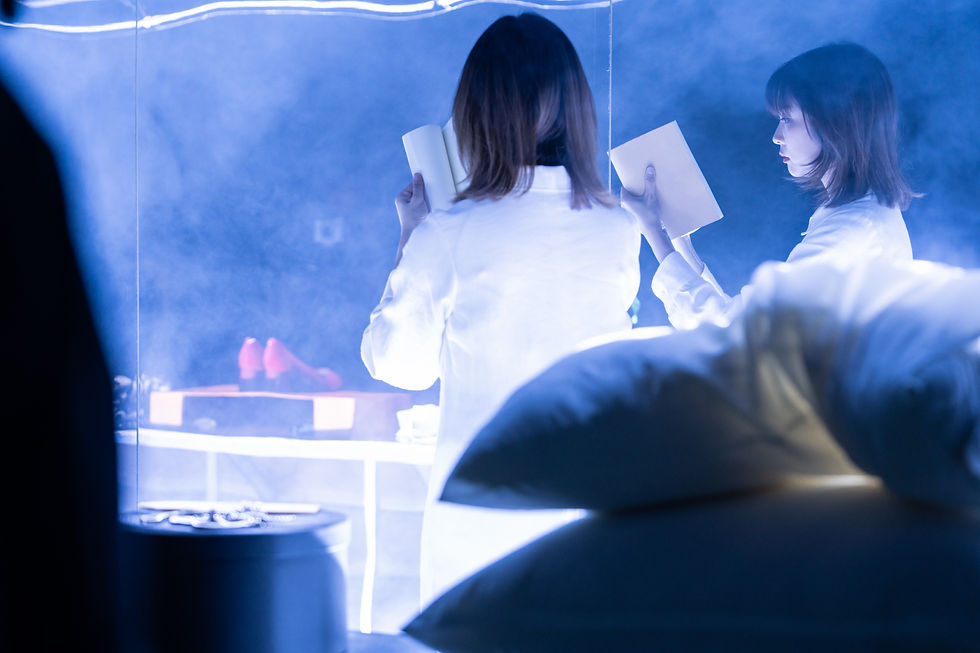【Curatorial Concept Breakdown】 Dreamlike Dream— A Journey Back to Self Through Dream
- Vanissa Law

- 5 hours ago
- 4 min read
此文章提供中英兩個版本,請在右上角選擇語言。
At some point, every one of us has asked: “Who am I, really?” Yet Zhuangzi never encouraged us to search for this answer—because he believed the true self is always present, merely forgotten amid the disorder of daily life.
Dreamlike Dream is an invitation to rediscover the “natural heart”. Across six sensory encounters, Zhuangzi’s philosophy becomes something you can feel: shadows, palms, clouds, dreams, light—and your own pulse.
Here, I share the ideas behind this journey from a curator’s perspective.

《Book》The Things We've Lost Touch With
The exhibition begins with a few simple questions:
Did you sleep well last night?
Did you Dream?
These are basic messages from our body—signals we should pay attention to—yet they are often overlooked in the rush of urban life.
From these small questions, the space gently guides us towards a deeper one:
“Do you live for yourself, or are you running after a shadow?”
It is not about arriving at the “right” answer. It is a reminder that you may have lost touch with your own “natural heart”.
《Transformation》The Theory of Relativity
As you walk, you may notice books floating overhead. Upon reaching the second zone, they transform into pairs of pillows. This act of “becoming” refers to what Zhuangzi describes in The Theory of Equality of Things as transformation of things. It suggests that:
Everything is interconnected, constantly shifting and flowing. There is no absolute right or wrong, noble or base, success or failure.
We readily label the world around us:Boss / subordinate, success / failure.
But step back:
A boss is also someone else’s subordinate.
Teachers are, at the same time, someone’s students.
Those who succeed in one area may be struggling in others.
If boundaries were never truly fixed, is there any need to grasp them so tightly?

《Slumber》Consciousness in sleep, and the unknown
Books become pillows because this entire project began with the Butterfly Dream.
What is dreaming? What is waking? Am I the butterfly, or is the butterfly dreaming me?
Zhuangzi offers no solution.Instead, he proposes that life itself is lived within the unknown.
Hence the title Kownless:
the consciousness we possess during sleep,
and a homophone of “the unknown”.
Blurred, fluid, indistinct—this is the most truthful condition of being alive.
《Palm》Let go, and the world becomes clearer
In "Enjoyment in Untroubled Ease", Zhuangzi writes: “The perfected person has no self; the spirit-like person has no achievements; the sage has no name.”
The highest state is not defined by what you accomplish, but by what you are able to release.
This is why the work uses the palm as a symbol.Letting go is not merely conceptual—it is physical, a gesture the body can remember.
Many of our pains come from our insistence on “holding on”.The tighter the grip, the less we see ourselves, and the less we feel the present moment.
Opening your palm is not giving up—it is making space.
《Shadow》Not in control? Then what of it?
In "The Seal of Virtue Complete", Shadow asks Shape:
“You stand, so I stand. You move, so I move. You stop, so I stop. Am I being dragged by you? Do I have any will of my own?”
Shape replies:
“I am not in control either. I am moved by light, by circumstance, by the world around me. You follow me, and I follow Heaven and all things.Everything is in motion; no one truly masters anything.”
Shadow follows Shape, and Shape follows the world. We imagine ourselves to be fully in control, yet we are equally shaped by emotion, environment, relationships and the times. If complete control is impossible, why not learn to accept things with ease? Shadow reminds us of the wisdom of moving with change.

《Loss of Self》Entering the room of “nothingness”
Once you have released your grip, you enter a room close to “emptiness”. No external distraction—only your pulse.
Light and sound respond to your heartbeat,reducing the world to its most intimate rhythm. On the ceiling, tucked away, are Li Chi-Tak’s illustrations from the project’s first phase—quiet responses to fourteen philosophical questions posed by the curators.A small easter egg within the exhibition. In this space of “nothingness”, thoughts settle. You meet yourself.

《Clouds》Dreaming? Flying? Or perhaps they were never separate
Emerging from “nothingness”, you step into cloud.
Hazy, drifting, uncertain—it feels like dreaming, yet also like flight.
Here, you may wonder:“Am I dreaming?”“Or am I flying?”
The answer doesn’t matter.What matters is this:
You have stepped beyond the boundaries, and entered a freer space.

《Now》Finding truth amidst the delightful mismatch
If this final zone feels “strange” or “nonsensical”, then good—you have entered the language of dreams. Dreams are, by nature, delightfully mismatched. Live video feed, live performance, panoramic projection, shadows and bodies interacting—you cannot take in everything at once. The world is similar: we only ever grasp fragments.
So why cling to a single “truth”?
Zhuangzi reminds us that: All things are equal;everything is in flux; nothing is absolute. Once we understand this, we return to the present, appreciate the moment, and gain freedom of thought. This is the "enjoyment of untroubled ease"—wandering beyond.
Epilogue: The person you meet in the dream is you
Dreamlike Dream does not offer answers. It offers a journey.
Slow down, pause, loosen your grip,and you may discover—
The “true self” you have been searching for has been here all along.




Comments